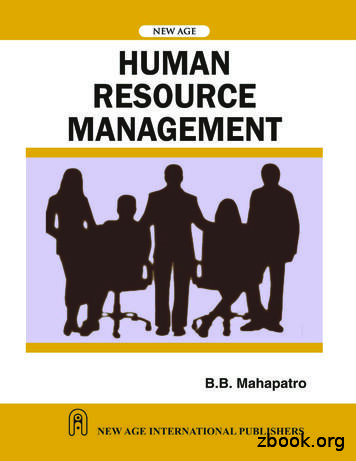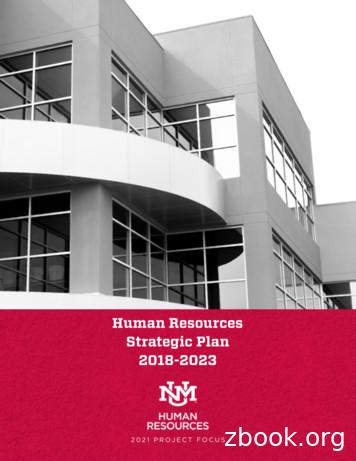Human Resources Management - Captus
Human Resources ManagementCOURSE AUTHORDr. Monica Belcourt, School of Human Resource Management, York UniversityCOURSE INSTRUCTORVita LoboCOURSE DESCRIPTIONWelcome to the exciting world of managing people. I guarantee you that 80% of yourproblems at work will involve people. There are professional and time solutions toproblems of financial projections and product launches . and I will argue throughoutthe course that there are technical solutions to problems such as hiring the bestpeople and giving them performance feedback which motivates productivity.Everyone who is a coach, a volunteer leader or a manager needs knowledge and skillsin the art and science of managing people.The study of Human Resources Management will help you handle these situations.Furthermore, if you plan to be a manager in an organization, then knowledge aboutwhat the department of human resources can do for you is very important.Human resources management is not AN academic subject to be learned andforgotten, but is an important body of knowledge to be used throughout your life.This guide will help you master that subject.REQUIRED TEXTBelcourt, M., Singh, P., Snell, S. & Morris, S., Managing Human Resources, NinthCanadian Edition, ITP Nelson, Toronto, Canada, 2020, ISBN 0176798056.COURSE DURATION 12-14 WeeksIt is expected that students will progress through approximately 1.5 units per weekand spend about 3 hours per unit accessing the multimedia with interactive questions,working with self-help quizzes and participating in the discussion boards. Additionaltime will be required for the readings, midterm paper and final examination.1
COURSE CONTENTSMultimedia Lectures by Professor Monica Belcourt, York UniversityUnit One: The Challenge of Human Resources ManagementLearning Objectives Explain how human resource managers can help their organization gain asustainable competitive advantage through the strategic utilization of people. Explain how good human resources practices can help a firm achieve itsglobalization, corporate social responsibility and sustainability goals. Describe how technology can improve how people perform and are managed. Understand how to achieve productivity and reduce costs. Discuss how firms can leverage employee differences to their strategicadvantage and explain how educational and cultural changes in the workforceare affecting human resource management. Provide examples of the roles and competencies of today’s human resourcesmanagers.Readings: Chapter 1Unit Two: Strategy and Human Resources PlanningLearning Objectives Explain how human resources planning and a firm’s mission, vision and valuesare linked to its strategy. Understand how an organization’s competitive environment influences strategicplanning. Understand why it is important for an organization to do an internal resourceanalysis. Explain the linkages between competitive strategies and HR. Understand what is required for a firm to successfully implement a strategy. Recognize the methods for assessing and measuring the effectiveness ofstrategy.2
Readings: Chapters 2Unit Three: Equity and Diversity in Human Resources ManagementLearning Objectives Explain the reasons for employment equity legislation. Identify the legal framework, including the Charter and human rightslegislation. Describe pay equity and strategies for implementing it. Discuss the Employment Equity Act with respect to its origins, its purpose andits continued enforcement and the implementation of employment equity inorganizations. Discuss sexual harassment as an employment equity issue. Explain and give examples of diversity management.Readings: Chapters 3Unit Four: Job Analysis and Work DesignLearning Objectives Discuss the relationship between job requirements and the performance of HRMfunctions. Indicate the methods by which job analysis typically is completed. Identify andexplain the various sections of job descriptions. Provide examples illustrating the various factors that must be taken intoaccount in designing a job. Describe the different group techniques and types of work schedules used tomaximize employee contributions.Readings: Chapter 43
Unit Five: Expanding the Talent Pool: Recruitment and CareersLearning Objectives Describe how a firm’s strategy affects its recruiting efforts. Outline the methods by which firms recruit internally. Outline the methods by which firms recruit externally. Explain the techniques organizations can use to improve their recruitingefforts. Explain how career management programs integrate the needs of individualemployees and their organizations.Readings: Chapter 5Unit Six: Employee SelectionLearning Objectives: Explain the objectives of the personnel selection process and why theinformation must be reliable and valid. Describe the tools used to screen applicants, the types of employmentinterviews and the post screening tools. Compare the value of different types of employment tests. Explain how organizations evaluate the information that they collect on a groupof candidates, and the strategies that they use to select employees.Readings: Chapter 6Unit Seven: Training and DevelopmentLearning Objectives Discuss the scope of training and development, and its strategic aspects. Describe how a training-needs assessment should be done. Describe the factors that should be considered when designing a trainingprogram.4
Identify the types of training methods organizations use. Explain how the effectiveness of training programs is evaluated and describesome of the additional training programs offered by organizations.Readings: Chapter 7Unit Eight: Appraising and Improving PerformanceLearning Objectives Explain what performance management is. Describe the different sources of management information Explain the various methods used for performance evaluation. Outline the characteristics of an effective performance evaluation meeting andfeedback sessions with the goal of improving employee performance.Readings: Chapter 8Unit Nine: Managing CompensationLearning Objectives Explain how to develop a strategic compensation system. Indicate the various factors that influence the setting of wages. Determine how to design pay systems Identify the major provisions of the laws and regulations affectingcompensation. Discuss the current issues of equal pay for work of equal value and paycompression.Readings: Chapters 95
Unit Ten: Pay For Performance: Incentive RewardsLearning Objectives Discuss the basic requirements for successful implementation of incentiveprograms. Identify the types of, and reasons for implementing, individual incentive plans,and under what conditions individual incentives are appropriate. Indicate the advantage of each of the principal methods used to compensatesalespeople. Identify the key aspects of team and group pay for performance plans. Differentiate between profit-sharing plans and explain advantages anddisadvantages of these programs. Describe the main types of ESOP plans and discuss their advantages toemployers and employees.Readings: Chapter 10Unit Eleven: Employee BenefitsLearning Objectives Describe key characteristics of managing employee benefits and thecharacteristics of programs that are cost effective. Identify and explain the employee benefits required by law. Describe benefits that involve payment for time not worked. Discuss the recent trends in retirement policies and programs and indicate themajor factors involved in the management of pension plans. Describe the types of work/life benefits that employers may provide.Readings: Chapter 116
Unit Twelve: Safety and HealthLearning Objectives Summarize the common elements of federal and provincial occupational healthand safety legislation. Describe the measures that management and employees can take to create asafe work environment. Identify the ways to control and eliminate health hazards. Describe the organizational services and programs for building better health.Readings: Chapter 12Unit Thirteen: Employee Rights and DisciplineLearning Objectives Explain the different regimes that govern the employment relationship and therules that apply to employment contracts. Identify and explain the privacy rights of employees. Explain the process of establishing disciplinary policies. Differentiate between the two approaches to disciplinary action. Identify the different types of alternative dispute resolution procedures.Readings: Chapter 13Unit Fourteen: The Dynamics of Labour RelationsLearning Objectives Identify and explain the federal and provincial legislation that provide theframework for labour relations. Explain why employees join unions and describe the process by which unionsorganize employees and gain recognition as their bargaining agent.7
Discuss the bargaining process and the bargaining goals and strategies of aunion and an employer. Differentiate the forms of bargaining power that a union and an employer mayutilize to enforce their bargaining demands. Describe a typical union grievance procedure and explain the basis forarbitration awards.Readings: Chapter 14Unit Fifteen: International Human Resources ManagementLearning Objectives Explain the economic, political, and cultural factors in different countries thatHR managers need to consider. Identify the types of organizational forms used for competing internationally. Explain how domestic and international HRM differ and discuss the recruitment,selection, training, compensation and performance appraisal needs fordifferent types of employees working across borders. Explain how labour relations differ around the world.Readings: Chapter 15Learning AidsInteractive questions within the multimedia lecture streams. Self help quiz attachedto each unit of the course.ParticipationDiscussion board moderated and graded by the instructor. Students are required topost at least 3 substantial submissions (400 words or more) during the course onassigned questions (topical and case study based) that demonstrate knowledge andskills congruent with the Learning Objectives. There will be instructor feedback on allsubmissions.There will also be a General Discussion Board moderated by the instructor in whichquestions can be asked on any course topic.8
Midterm PaperA midterm paper of approximately 1500 words to be submitted online approximately 6weeks after the start of the course. Concepts and theories to be applied in the papershall be from Units 1 to 6. The instructor shall grade and comment on each paper,which shall be returned to the student.Final ExaminationProctored, opened book, online examination consisting of essay question(s). Any partof the entire course content may be examined. Government issued photoidentification will be required to verify the student’s identity.Grade Weightings of Course ComponentsParticipation in Discussion Board: Weighting 10%Midterm Paper: Weighting 35%Final Examination: Weighting 55%: (It is required to pass the final examination with agrade of at least 65% in order to pass the course, regardless of grades earned in othercomponents.)Passing Grade for the Course: 65%9
are affecting human resource management. Provide examples of the roles and competencies of today's human resources managers. Readings: Chapter 1 Unit Two: Strategy and Human Resources Planning Learning Objectives Explain how human resources planning and a firm's mission, vision and values are linked to its strategy.
2‖ high, stroked with a 1.5 pt white frame and positioned edge-to-edge with accompanying images. Calibration & Use of a Capintec CAPTUS 3000 Portable Thyroid Uptake System for Iodine-125 Bioassay Measurements Todd W.
1374 Strategic Human Resources Planning Course Author: Dr. Monica Belcourt, School of Human Resource Management, York University; Ron Alexandrowich and Mark Podolsky Course Instructor: Gordon Wang Description: The course provides students with an understanding of the personnel planning process, the quantitative and qualitative techniques used in forecasting personnel requirements, and possible
1.3 Definition of Human Resources Management 3 1.4 A New Mandate for Human Resources 4 1.5 Changing Role of the Human Resource Management 5 1.6 Managing human resources in the emerging scenario 7 1.7 Evolution of Management of Human Resources: An Indian Perspective 10 References 16 2. THE CONCEPT, SCOPE AND FUNCTION OF HUMAN RESOURCE OF .
Konsep Human Resources Scorecard (HRSC) 1. HUMAN RESOURCES SCORECARD Apa yang dimaksud dengan Human Resources Scorecard (HRSC)? Human Resources Scorecard adalah suatu atat untuk mengukur dan mengelola kontribusi stategik dari peran human resources dalam menciptakan nilai untuk mencapai strategi perusahaan.
Chapter 1 establishes the importance of occupational health and safety (H&S) from an economic, legal and moral obligation. This chapter also establishes the major obligations of all the stakeholders involved in H&S. Finally, the role of human resources management and health and safety professionals is discussed. Learning Objectives:
Human Resources Management role: The Human Resources department plays an important role in the implementation and success of the performance management system, with all the desired results and outputs. The responsibility of system care and coordination among all concerned parties' rests with the human resources department. Human Resources
Human Resources Strategic Plan 2018-2023 2021 PROJECT FOCUS. A MESSAGE FROM THE VICE PRESIDENT OF HUMAN RESOURCES Over the period of five years, Human Resources will strive to deliver exceptional service and resources in an . The division of Human Resources and Graduate Studies have begun
12 dimana manajer menggeser laba tahun berjalan dengan kemungkinan laba di masa mendatang. Sedangkan menurut Kustono (2009), perataan laba dapat didefinisi sebagai suatu cara yang dipakai manajemen untuk mengurangi variabilitas laba di antara deretan jumlah laba yang timbul karena adanya perbedaan antara jumlah laba yang seharusnya dilaporkan dengan laba yang diharapkan (laba normal). 2.2.2 .























